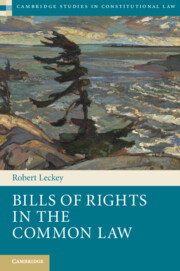Book contents
- Frontmatter
- Dedication
- Contents
- Acknowledgements
- Table of cases
- Introduction
- 1 Against bill-of-rights exceptionalism
- 2 The common law, judging, and three bills of rights
- 3 Judicial review of legislation before bills of rights
- 4 Bills of rights and other means of accessing judgment
- 5 Putting the strike-down in its place
- 6 Remedies from text to practice
- 7 Improving the system and engaging the legislature
- 8 Rethinking remedies and constitutional supremacy
- Conclusion
- Bibliography
- Index
2 - The common law, judging, and three bills of rights
Published online by Cambridge University Press: 05 May 2015
- Frontmatter
- Dedication
- Contents
- Acknowledgements
- Table of cases
- Introduction
- 1 Against bill-of-rights exceptionalism
- 2 The common law, judging, and three bills of rights
- 3 Judicial review of legislation before bills of rights
- 4 Bills of rights and other means of accessing judgment
- 5 Putting the strike-down in its place
- 6 Remedies from text to practice
- 7 Improving the system and engaging the legislature
- 8 Rethinking remedies and constitutional supremacy
- Conclusion
- Bibliography
- Index
Summary
This chapter lays two essential foundations for the rest of the book. Relating to the common law and to judging, one underwrites the book's focus on the procedure and technique of judges' application of bills of rights, and it runs across the chapter's first two parts. The first part emphasizes the importance of procedure in the history of the common law, contrasting it with the attention to substantive values that prevails in research associated with common-law constitutionalism. This part also sketches the judicial role at common law, developing the law while resolving disputes. The second part presents statutory and contractual interpretation as examples of creative enterprises that engage the judges in attributing meaning to authoritative texts. In doing so, it rejects accounts of interpretation apart from a bill of rights as a technical, essentially uncreative exercise. This part provides resources for challenging bill-of-rights exceptionalism, which supposes that the potential for judicial overreach in applying a bill of rights is novel and thereby overlooks the kinship between remedies in rights cases and practices of statutory interpretation. This account of judging before the adoption of rights instruments is essential for delineating judicial agency in rights cases.
The other foundation concerns the three selected bills of rights. The chapter's last three parts offer brief overviews of the Canadian Charter of Rights and Freedoms, the Bill of Rights in the final Constitution of South Africa, and the United Kingdom's Human Rights Act 1998. To facilitate comparison, those parts address several features: the instruments' form, source, and normative status, including the amendment process; the rights or interests they protect; their scopes of application; and the means of their enforcement, including the consequences of non-compliance.
Procedure and judging in the common law
This part underscores the contrast between common-law constitutionalism's emphasis on substantive values and its relative neglect of procedural aspects of judging.
- Type
- Chapter
- Information
- Bills of Rights in the Common Law , pp. 34 - 51Publisher: Cambridge University PressPrint publication year: 2015



